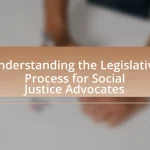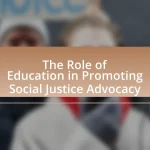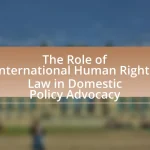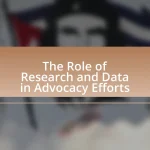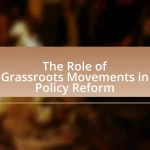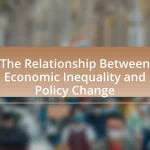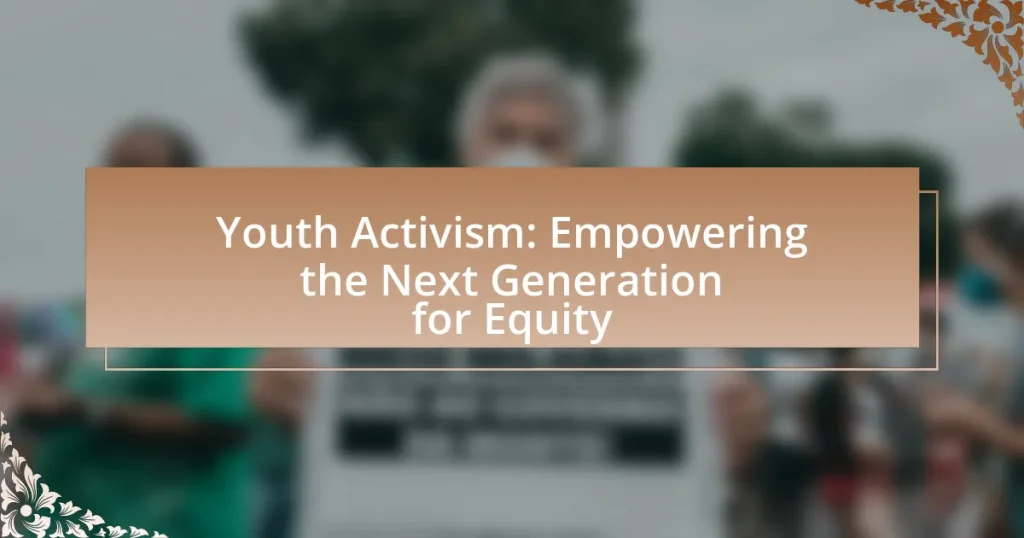Youth activism refers to the active engagement of young individuals in advocating for social, political, and environmental change, empowering them to influence decision-making processes on critical issues such as climate change, education reform, and social justice. The article explores how youth activism manifests in contemporary society through organized movements and social media campaigns, highlighting its significance in promoting equity and addressing systemic inequalities. It also examines the challenges faced by youth activists, including funding limitations and societal perceptions, while emphasizing the importance of education, resources, and leadership training in empowering young people to engage effectively in activism. Additionally, the article provides successful examples of youth-led movements and outlines practical steps for young individuals to identify their passions and mobilize their peers for activism.
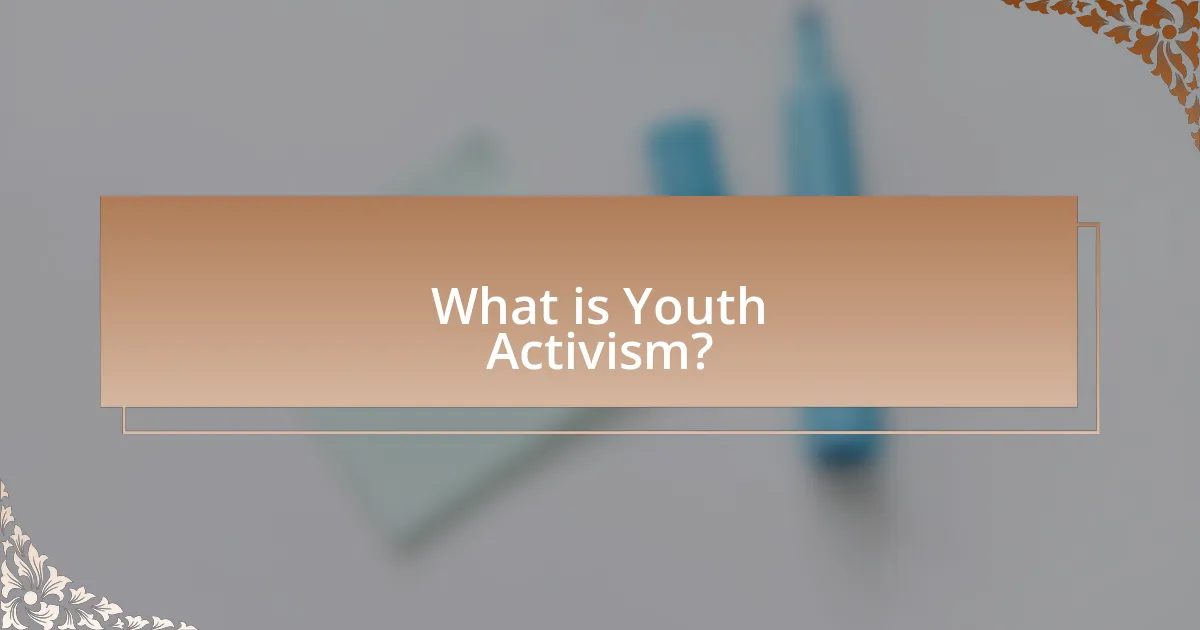
What is Youth Activism?
Youth activism is the engagement of young people in advocating for social, political, and environmental change. This form of activism empowers youth to voice their concerns and influence decision-making processes, often addressing issues such as climate change, education reform, and social justice. Historical examples include the March for Our Lives movement, initiated by students in response to gun violence, which mobilized thousands and highlighted the power of youth voices in shaping public policy.
How does Youth Activism manifest in today’s society?
Youth activism manifests in today’s society through organized movements, social media campaigns, and participation in political processes. Young people are increasingly mobilizing around issues such as climate change, racial justice, and gun control, often utilizing platforms like Instagram and TikTok to raise awareness and galvanize support. For instance, the global climate strikes initiated by Greta Thunberg in 2018 saw millions of youth participating worldwide, demonstrating their collective power and commitment to environmental issues. Additionally, surveys indicate that 70% of young people believe they can influence political decisions, highlighting their engagement in advocacy and policy-making. This active involvement reflects a significant shift in societal dynamics, where youth voices are becoming pivotal in shaping discussions around equity and justice.
What are the key characteristics of Youth Activism?
Youth activism is characterized by its focus on social justice, community engagement, and the empowerment of young individuals to effect change. This form of activism often emphasizes grassroots organizing, where youth mobilize their peers to address issues such as climate change, racial inequality, and education reform. Research indicates that youth activists frequently utilize digital platforms for advocacy, allowing for rapid dissemination of information and mobilization of support, as seen in movements like March for Our Lives and Fridays for Future. Additionally, youth activism is marked by a strong sense of identity and purpose, with young activists often drawing on personal experiences to inform their advocacy efforts.
How do different cultures influence Youth Activism?
Different cultures significantly influence youth activism by shaping values, beliefs, and methods of engagement. For instance, collectivist cultures often emphasize community and collaboration, leading youth to organize group efforts for social change, as seen in movements like the Indigenous rights activism in Canada, where community consensus is vital. Conversely, individualistic cultures may encourage personal expression and innovation, resulting in unique forms of activism, such as the use of social media platforms for advocacy in the United States. Research indicates that cultural context affects the priorities of youth activists; for example, a study by the International Youth Foundation highlights that youth in developing countries often focus on issues like education and employment, while those in developed nations may prioritize climate change and social justice. This cultural lens not only informs the issues youth choose to address but also the strategies they employ, demonstrating the profound impact of cultural backgrounds on youth activism.
Why is Youth Activism important for social equity?
Youth activism is important for social equity because it empowers young individuals to advocate for their rights and the rights of marginalized communities. This engagement fosters awareness of social injustices and mobilizes collective action, leading to policy changes that promote equity. For instance, youth-led movements like the March for Our Lives have successfully influenced gun control legislation, demonstrating the tangible impact of youth activism on social policies. Additionally, studies show that youth participation in activism enhances civic engagement, leading to a more informed and active citizenry that prioritizes equity in societal structures.
What role does Youth Activism play in promoting equity?
Youth activism plays a crucial role in promoting equity by mobilizing young people to advocate for social justice and policy changes that address systemic inequalities. This activism empowers youth to voice their concerns on issues such as climate change, racial justice, and education reform, thereby influencing public discourse and decision-making processes. For instance, movements like March for Our Lives and Black Lives Matter have demonstrated how youth-led initiatives can effectively challenge inequitable practices and demand accountability from institutions. Research indicates that youth engagement in activism not only raises awareness but also fosters a sense of agency and responsibility among young people, leading to sustained efforts toward achieving equity in society.
How can Youth Activism address systemic inequalities?
Youth activism can address systemic inequalities by mobilizing young people to advocate for policy changes and social justice initiatives. Through organized efforts, youth activists raise awareness about issues such as racial discrimination, economic disparity, and climate justice, effectively challenging the status quo. For example, movements like Black Lives Matter, which gained significant traction among youth, have highlighted systemic racism and prompted legislative discussions on police reform. Additionally, youth-led initiatives often utilize social media platforms to amplify their messages, reaching wider audiences and fostering community engagement. This grassroots approach not only empowers young individuals but also influences decision-makers to consider the perspectives and needs of marginalized communities, thereby contributing to systemic change.
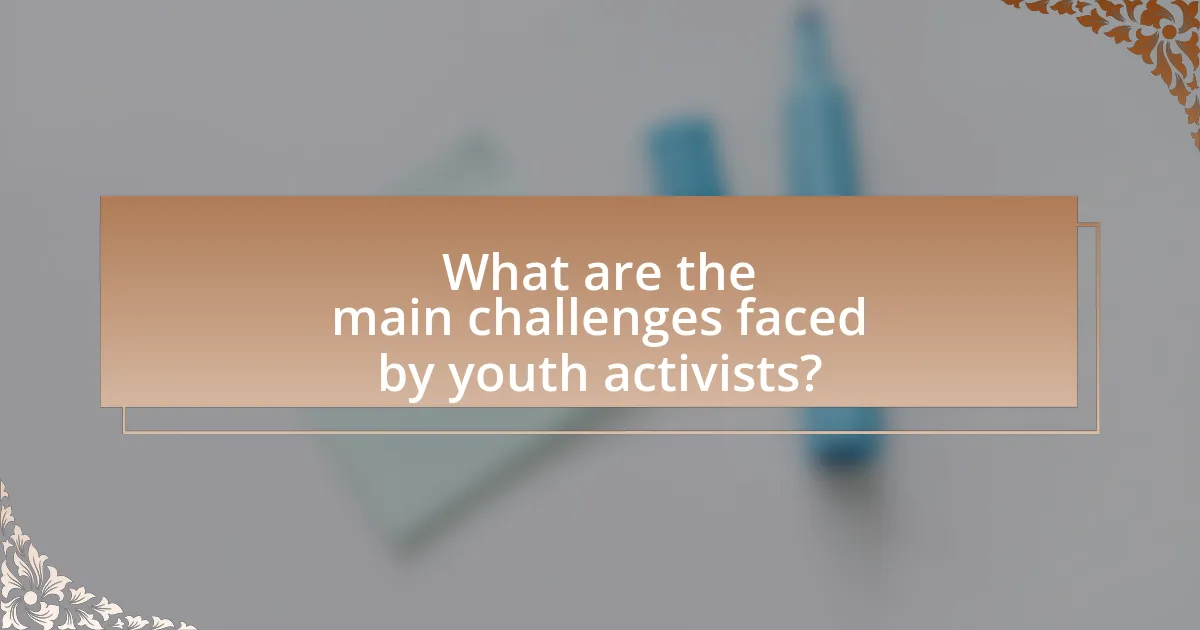
What are the main challenges faced by youth activists?
Youth activists face several main challenges, including lack of funding, limited access to decision-making processes, and societal pushback. Funding is often scarce, as many youth-led initiatives struggle to secure financial support, which hampers their ability to implement projects effectively. Additionally, youth activists frequently encounter barriers in accessing platforms where decisions are made, limiting their influence on policies that affect their communities. Societal pushback can manifest as criticism or dismissal of their efforts, often undermining their credibility and motivation. These challenges are documented in various studies, such as the “Youth Activism and Social Change” report by the International Youth Foundation, which highlights the systemic obstacles that hinder youth engagement in activism.
How do societal perceptions impact Youth Activism?
Societal perceptions significantly influence youth activism by shaping the opportunities and challenges young activists face. Positive perceptions can empower youth, encouraging their participation in social movements, as seen in the global response to climate change led by figures like Greta Thunberg, which garnered widespread support and media attention. Conversely, negative perceptions can marginalize youth voices, leading to skepticism about their capabilities and motivations, as evidenced by studies showing that adults often underestimate the impact of youth-led initiatives. This dynamic illustrates that societal attitudes directly affect the visibility, legitimacy, and effectiveness of youth activism.
What stereotypes do youth activists encounter?
Youth activists encounter stereotypes that portray them as inexperienced, naive, or overly emotional. These stereotypes often stem from the perception that young people lack the knowledge and life experience necessary to engage in serious social and political issues. Research indicates that older generations frequently dismiss youth perspectives, viewing their activism as impulsive rather than informed. For example, a study by the Pew Research Center found that 70% of adults believe that young people are not as knowledgeable about political issues compared to older individuals. This dismissal can undermine the legitimacy of youth activism and discourage young people from participating in advocacy efforts.
How can these perceptions be changed?
Perceptions can be changed through targeted education and awareness campaigns that highlight the importance of youth activism in promoting equity. By providing young people with platforms to share their experiences and insights, communities can foster a deeper understanding of the issues at hand. Research indicates that when youth engage in activism, they not only develop critical thinking skills but also influence their peers and adults, leading to a shift in societal attitudes. For instance, a study by the Harvard Kennedy School found that youth-led movements significantly impact public policy and community engagement, demonstrating the effectiveness of empowering young voices in changing perceptions.
What barriers do youth activists face in their efforts?
Youth activists face several barriers in their efforts, including lack of funding, limited access to decision-making processes, and societal skepticism. Funding challenges often stem from the perception that youth-led initiatives are less credible, which can hinder their ability to secure resources. Limited access to decision-making processes occurs when young activists are excluded from platforms where policies are shaped, reducing their influence on critical issues. Societal skepticism manifests in the form of ageism, where the contributions of youth are undervalued, leading to diminished support for their initiatives. These barriers collectively impede the effectiveness and reach of youth activism.
How does access to resources affect Youth Activism?
Access to resources significantly enhances youth activism by providing the necessary tools, information, and platforms for effective engagement. When young activists have access to financial support, educational materials, and technology, they can organize campaigns, raise awareness, and mobilize their peers more efficiently. For instance, a study by the International Youth Foundation found that youth-led organizations with adequate funding were able to reach 50% more participants in their initiatives compared to those without financial resources. This demonstrates that resource availability directly correlates with the impact and reach of youth activism efforts.
What legal challenges do youth activists encounter?
Youth activists encounter legal challenges such as restrictions on assembly, limitations on free speech, and potential criminal charges for protests. These challenges arise from laws that regulate public demonstrations and the expression of dissenting opinions, often disproportionately affecting younger individuals. For instance, in the United States, laws in various states impose curfews or require permits for protests, which can hinder youth-led movements. Additionally, youth activists may face legal repercussions for civil disobedience, as seen in cases where young protesters have been arrested for participating in climate strikes or social justice demonstrations. These legal barriers can discourage youth engagement in activism and limit their ability to advocate for change effectively.

How can youth be empowered to engage in activism?
Youth can be empowered to engage in activism by providing them with education, resources, and platforms for expression. Educational programs that focus on social justice, civic engagement, and critical thinking equip young individuals with the knowledge necessary to understand societal issues. Access to resources, such as funding for projects and mentorship from experienced activists, enables youth to implement their ideas effectively. Additionally, creating platforms for youth voices, such as social media campaigns and community forums, fosters a sense of agency and encourages participation. Research shows that youth-led movements, like the March for Our Lives, have significantly influenced policy discussions, demonstrating the impact of empowered youth activism.
What skills are essential for effective youth activism?
Effective youth activism requires strong communication skills, critical thinking, and organizational abilities. Communication skills enable youth activists to articulate their messages clearly and engage with diverse audiences, which is essential for mobilizing support and raising awareness. Critical thinking allows them to analyze social issues, evaluate different perspectives, and develop informed strategies for advocacy. Organizational abilities are crucial for planning events, coordinating campaigns, and managing resources efficiently. These skills collectively empower youth to drive meaningful change and influence policy decisions, as evidenced by successful movements led by young activists, such as the March for Our Lives campaign, which effectively utilized these skills to advocate for gun control reforms.
How can communication skills enhance activism efforts?
Communication skills enhance activism efforts by enabling activists to effectively convey their messages, mobilize supporters, and influence public opinion. Effective communication allows activists to articulate their goals clearly, making it easier to engage diverse audiences and foster understanding. For instance, studies show that campaigns utilizing strong messaging strategies can increase participation rates by up to 50%. Furthermore, skilled communicators can adapt their messages to resonate with different demographics, thereby broadening their reach and impact. This adaptability is crucial in youth activism, where connecting with peers through social media and other platforms can amplify voices and drive collective action.
What role does leadership training play in empowering youth?
Leadership training plays a crucial role in empowering youth by equipping them with essential skills such as decision-making, communication, and teamwork. These skills enable young individuals to take initiative, advocate for their beliefs, and engage effectively in their communities. Research indicates that youth who participate in leadership training programs demonstrate increased self-confidence and a greater sense of agency, which are vital for active participation in civic life. For instance, a study by the National 4-H Council found that youth involved in leadership programs showed a 25% increase in leadership skills and a 30% increase in community engagement. This evidence underscores the transformative impact of leadership training on youth empowerment, fostering a generation capable of driving social change and promoting equity.
What resources are available to support youth activists?
Youth activists can access various resources, including funding opportunities, training programs, mentorship networks, and online platforms for collaboration. Organizations such as the Youth Activism Project provide grants and support for youth-led initiatives, while programs like the Global Youth Mobilization offer training in advocacy and leadership skills. Additionally, platforms like Change.org enable youth to create petitions and mobilize support for their causes. These resources are designed to empower young individuals to effect change and promote equity in their communities.
How can online platforms facilitate Youth Activism?
Online platforms facilitate youth activism by providing accessible spaces for communication, organization, and mobilization. These platforms enable young activists to connect with like-minded individuals, share information rapidly, and coordinate events or campaigns effectively. For instance, social media networks like Twitter and Instagram have been instrumental in movements such as Black Lives Matter, where hashtags and viral posts have raised awareness and mobilized support globally. Research indicates that 70% of young people believe social media is an effective tool for activism, highlighting its role in empowering youth voices and fostering community engagement.
What organizations provide support and mentorship for young activists?
Organizations that provide support and mentorship for young activists include the Youth Activism Project, which offers resources and training for youth-led initiatives, and the Global Youth Action Network, which connects young leaders globally to share strategies and experiences. Additionally, the Sierra Club’s Inspiring Connections Outdoors program focuses on environmental activism, while the National Youth Leadership Council promotes service-learning and civic engagement among youth. These organizations empower young activists by providing training, networking opportunities, and resources tailored to their specific causes and interests.
What are some successful examples of Youth Activism?
Successful examples of youth activism include the March for Our Lives movement, initiated by students from Marjory Stoneman Douglas High School in response to the 2018 school shooting in Parkland, Florida. This movement successfully advocated for gun control legislation, resulting in the passage of several laws aimed at reducing gun violence in various states. Another notable example is the Fridays for Future movement, started by Greta Thunberg, which mobilized millions of young people globally to demand action on climate change, influencing international climate policy discussions and leading to increased awareness and commitments from governments. Additionally, the Black Lives Matter movement has seen significant youth involvement, particularly during the protests following the death of George Floyd in 2020, leading to widespread discussions on racial justice and police reform across the United States and beyond. These examples demonstrate the impactful role of youth in driving social change and influencing policy.
How have youth-led movements influenced policy changes?
Youth-led movements have significantly influenced policy changes by mobilizing public opinion and advocating for legislative reforms. For instance, the March for Our Lives movement, initiated by students after the Parkland shooting in 2018, successfully pushed for gun control measures in several states, leading to the enactment of laws such as Florida’s gun safety legislation. Additionally, the climate strikes led by youth activists like Greta Thunberg have prompted governments worldwide to adopt more aggressive climate policies, including commitments to reduce carbon emissions and invest in renewable energy. These movements demonstrate the power of youth advocacy in shaping policy agendas and driving legislative action.
What lessons can be learned from successful youth activism campaigns?
Successful youth activism campaigns demonstrate the importance of grassroots organization, effective communication, and leveraging social media for mobilization. Grassroots organization allows young activists to build strong community ties and foster collective action, as seen in the March for Our Lives movement, which effectively united students across the United States to advocate for gun control following the Parkland shooting. Effective communication is crucial; campaigns that articulate clear, relatable messages resonate more with the public, as evidenced by the climate strikes led by Greta Thunberg, which galvanized global attention on climate change. Additionally, leveraging social media platforms enables rapid dissemination of information and mobilization of supporters, exemplified by the #BlackLivesMatter movement, which utilized Twitter and Instagram to raise awareness and organize protests. These lessons highlight the strategies that contribute to the success of youth-led initiatives in driving social change.
What practical steps can young people take to get involved in activism?
Young people can get involved in activism by educating themselves on social issues, joining local organizations, participating in community events, and using social media to raise awareness. Education allows them to understand the complexities of issues like climate change or social justice, which is essential for effective advocacy. Joining local organizations provides networking opportunities and resources for action, while participating in community events fosters a sense of solidarity and collective action. Utilizing social media platforms enables young activists to reach a broader audience, mobilize support, and share information quickly, as evidenced by movements like #BlackLivesMatter, which gained momentum through online engagement.
How can youth identify issues they are passionate about?
Youth can identify issues they are passionate about by engaging in self-reflection, exploring their interests, and participating in community activities. Self-reflection allows youth to consider their values and experiences, helping them recognize what matters most to them. Exploring interests through reading, volunteering, or attending events exposes them to various social issues, enabling them to discover areas they feel strongly about. Participation in community activities, such as local advocacy groups or social justice initiatives, provides practical experience and insight into pressing issues, further guiding their passions. Research indicates that youth who actively engage in these processes are more likely to develop a strong sense of civic identity and commitment to social causes, as highlighted in the study “Youth Civic Engagement: A Review of the Literature” by the National Youth Leadership Council.
What strategies can youth use to mobilize their peers for activism?
Youth can mobilize their peers for activism by utilizing social media platforms to raise awareness and organize events. Social media allows for rapid dissemination of information, enabling youth to share impactful stories, statistics, and calls to action that resonate with their peers. For instance, campaigns like #FridaysForFuture have successfully engaged millions of young people globally by leveraging platforms such as Instagram and Twitter to promote climate action. Additionally, youth can create inclusive spaces for dialogue, encouraging participation through workshops and community meetings, which fosters a sense of belonging and collective purpose. Research shows that peer-led initiatives are effective; a study by the Harvard Kennedy School found that youth-led movements often result in higher engagement levels among peers, as they feel more connected to their peers than to adult-led organizations.
